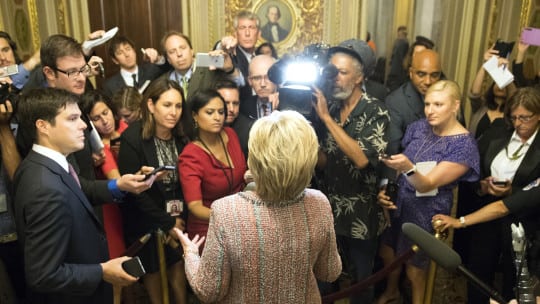
Based on my experiences as a journalist and PR practitioner, I have changed my mind about Hillary Clinton holding a press conference, which I thought she should do many weeks ago. The reason for my change of mind is that she is excelling at another method of reaching the public: answering media questions from local reporters during her campaign stops and individually with selected national reporters. This is the method I have frequently used and suggested to clients, both in the U.S. and internationally.
Here’s why I have always advised clients that there are better ways to gain media coverage than by holding bells-and-whistles press conferences:
- Press conferences during my days as a journalist had reporters asking detailed questions in order to report a story that contained news. That has largely gone the way of the Pony Express as reporters attempt to be the first to report a story, sometimes even before the press conference is concluded, meaning they are often the first to get it wrong.
- Press conferences have turned into a shark-like feeding frenzy as cable TV’s 24/7 reporters try to outdo each other with “gotcha” questions.
- Press conferences often lead to “pack journalism,” in which questions by a few aggressive reporters set the tone for all coverage.
- Reporters who arrive late or leave early get caught up by asking other reporters if they missed anything important. That’s bad journalism. What’s important to one reporter might not be important to another.
- When national TV cameras show up at a press conference, experience shows that the coverage is usually very short with the message points omitted. Often, even the reason for the event is omitted. The same is true for radio coverage of press conferences.
- And finally, reporters are known to get things wrong. That means that information they pass along to late-arriving reporters will be wrong.
Instead of mass press conferences, I believe the best and most efficient method of disseminating a client’s complete message is by arranging on-the-record meetings with the client and small groups of reporters. Some reporters who cannot attend are offered one-on-one meetings or telephone interviews. That way the reporters have the chance to ask penetrating questions without being held hostage by TV reporters, whose main objective is to ask a question that will afford them a few seconds of TV time, which often misrepresents the client’s position, as do the sound bites that often are the result. (I always favor offering TV interviews only to programs that afford the client sufficient time to reply to questions and eliminate “gotcha” programs, no matter how popular those programs are; same with print reporters).
I have dealt with hundreds of journalists during my PR career. The great majority said they, too, preferred these small gatherings, where they can have a chance to ask multiple follow-up questions in a controlled, relaxed setting.
I assume that before Election Day, Mrs. Clinton will hold at least one national press conference. But that will be for political reasons that are not associated with the overwhelming majority of PR clients.
PR people can learn valuable lessons by paying attention to the Clinton campaign’s media outreach. Following their lead assures a much better chance that the client’s talking points will be included in stories.
And one Very Important Point: Using the Clinton media outreach method permits PR people to control the media by choosing which reporters are offered the opportunity to attend interview sessions.
Arthur Solomon was a senior VP/senior counselor at Burson-Marsteller, a journalist and worked on election campaigns. He is on the Seoul Peace Prize nominating committee. He can be reached at: arthursolomon4pr@juno.com
